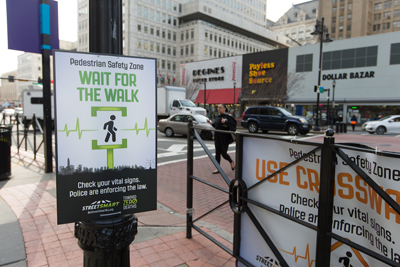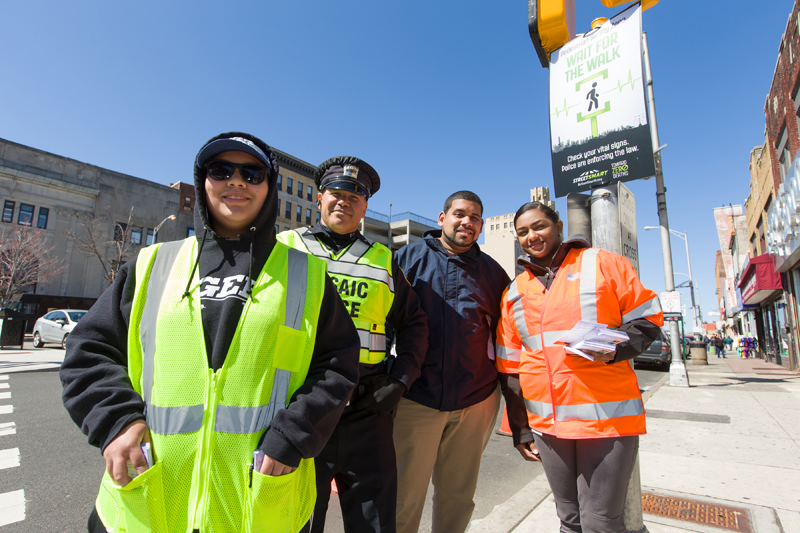Encouraging Street Smarts
New Jersey Pedestrian Safety Campaign Aims to Improve Behaviors, Reduce Fatalities

NJTPA
Newark was one of the first communities in New Jersey to pilot the Street
Smart NJ pedestrian safety initiative.They’re called smartphone zombies. Walking head down, so engaged in their phones they don’t notice other people around them, obstacles in their path or oncoming traffic.
Waking them up from their cell phones is one of the focuses of the “Heads Up, Phones Down” message that was added to the Street Smart NJ pedestrian safety campaign this year.
The message is two-fold. It also targets drivers who can’t resist the lure of their phones when they should be paying attention to the road—with often deadly consequences.
Street Smart NJ is coordinated by the North Jersey Transportation Planning Authority (NJTPA), which publishes InTransition magazine in partnership with the New Jersey Institute of Technology.
The campaign is one of a host of similar efforts across the country at all levels of government seeking to find creative and effective ways to promote safe travel behavior. Other campaigns include “See! Be Seen!” in New York State, “Safe Crossings” in Chicago, “Watch for Me” in North Carolina, “ePEDemic” in Las Vegas, “Walk Smart” in Ocean City, Md. and many more. There are also the broader “Vision Zero” efforts in major metropolitan areas, which aim to eliminate vehicle crash-related fatalities.
All of these initiatives aim at altering what Eric McAndrew, President of the communications firm McAndrew Company, calls the “impulsive behavior” involved in most travel.
“People are thinking about going from point A to point B. They’re not thinking about safety first and foremost,” he said.
So pedestrians jaywalk or motorists speed through crosswalks without a glance.
The Street Smart NJ campaign was motivated by a growing need. New Jersey ranks 14th in the nation in pedestrian fatalities and the Federal Highway Administration designated it a focus state. Between 2011 and 2014, 591 pedestrians were killed and more than 17,000 injured on the state’s roadways.
Street Smart NJ and other campaigns draw on advertising and branding techniques to create messages and narratives that can cajole and even shock travelers to pay attention to safety.
In northern New Jersey, the McAndrew Company helped the NJTPA create a “Check Your Vital Signs” campaign theme. In addition to “Heads Up, Phones Down,”
the vital signs for motorists are “Obey Speed Limit” and “Stop for Pedestrians” in crosswalks, while pedestrians are urged to “Use Crosswalks” and “Wait for the Walk”—all messages that correlate with pedestrian-related laws in New Jersey. The messages are deployed through multifaceted outreach—street teams, billboards, posters, social media, videos and more.
The campaign also created a series of “cinemagraphs”—still photos with subtle moving elements—that were viewed more than 500,000 times on social media.

STEVE HOCKSTEIN/HARVARDSTUDIO.COM
Street teams and police officers in Passaic, N.J. distributed safety information to pedestrians and motorists as part of the city's
Street Smart NJ campaign.
These creative aspects were matched by systematic efforts to use data to target locations where the messages would have the greatest impact, modify messages for specific audiences and evaluate the impacts of the campaign.
About 40 communities have undertaken local Street Smart NJ pedestrian safety campaigns so far, with others now underway or planned. The campaigns also include an enforcement component, with police issuing warnings and tickets to drivers and pedestrians breaking the law.
During a campaign from April 4 through May 31, 2016, in Morristown, N.J. the town hung eight banners and 80 posters along its streets. Paid teams and volunteers distributed 23,000 informational tip cards on the street and at events. Schools, business and community groups also promoted the messages, while police engaged in enhanced law enforcement activities.
The Morristown campaign was coordinated by TransOptions, a non-profit Transportation Management Association (TMA,) which provides ridesharing and commuting services. All eight of New Jersey’s TMAs are partnering with the NJTPA to conduct Street Smart NJ campaigns in 2016 and 2017. On August 25, representatives from each TMA met in Newark at the NJTPA’s office to share insights to help associations that are new to Street Smart NJ campaigns.
The first step is recruiting towns to participate. A data analysis by NJTPA identifies towns with the highest number of pedestrian injuries or fatalities due to crashes. But statistics are not enough.
“A community must be interested and show willingness and capacity to be successful,” Keith Hamas, NJTPA’s Street Smart NJ project manager, told the TMA gathering.
This includes gaining commitments from the mayor, other town leadership and the police department. Business groups, like Chambers of Commerce, can also be “invaluable partners,” according to Tara Shepherd, executive director of HART Commuter Information Services, a TMA.
HART conducted a Street Smart campaign in Clinton, N.J. in May and worked with the local business guild to gain support for the effort.
“Businesses not only displayed the messages but they chatted up [the campaign] with customers and it became kind of an ongoing community conversation,” she said.
Laura Cerutti of the TransOptions TMA related that police can contribute more than enforcement. When TransOptions conducted a campaign in Newton, N.J., she said the police department made pedestrian safety a topic of their ‘Coffee with a Cop’ community outreach program.
How aggressively to enforce pedestrian safety laws varies by community. Shepherd noted that some downtown businesses fear that ticketing will chase people from town.
“While people are committed to enforcing the law, they want to be community minded as well,” she said.
One way to balance the concerns is to have officers issue warnings, at least for the initial weeks of the campaign. On Long Beach Island in August, the town tried positive reinforcement: those crossing at crosswalks or obeying other laws were awarded t-shirts and coupons to local businesses.
Many of the local campaigns have been launched with a press event featuring local officials and community leaders. Particularly effective in garnering press coverage at the events has been testimony by victims, their family members or medical personnel. For example, at one event a retired police officer recounted the loss of his brother, who spent seven years in a coma after being hit by speeding vehicle.
At these events, NJTPA Executive Director Mary K. Murphy regularly cites the injury and fatality statistics that led to the campaign. She has called them “a grim and disturbing tally.”
Events have also featured live demonstrations of vehicle stopping distance at various speeds, with a child-size dummy as the potential victim.
In conducting campaign outreach, all towns deployed street teams and volunteers for one-on-one contact at key intersections.
“The messages are easy to relate to people because they know how important [safety] is,” said Kim Haas of Haas Media, which coordinated street teams and consulted on Street Smart NJ for the NJTPA.
She said a personal commitment is also important: “If you go to someone with a genuine interest in their well-being, they pick up on that, people feel it.” Just as important she says is “knowing your community,” including using team members fluent in Spanish or other languages spoken in a particular neighborhood.
Social media has opened up other effective means for communicating messages, particularly for young people. In addition to free posts on Facebook, Twitter and other outlets, Street Smart NJ used paid advertising on Facebook and Pandora radio. Facebook allows messages to be targeted to specific areas and provides data about who is viewing the ads and how they are being shared. Facebook also allows messages to be varied—including switching out headlines and photos—to test which garner the greatest number of impressions.
This fine-tuning is of great benefit, McAndrew said, because “people have different motivations, are at different stages of their lives and people just have different preferences.”
Whether on social media or the street, the messages appear to be having an impact. Before and after surveys are conducted in selected municipalities to gauge awareness of pedestrian safety and the Street Smart NJ messages. The results found an average increase in awareness from 10 to 20 percent.
The evaluation also looks at how the campaign directly effects traveler behavior. To assess that, teams were deployed at selected, high traffic intersections to observe and compare pedestrian and driver behaviors before and after campaigns. In some cases, they used video cameras to capture activity and later tally unsafe practices.
Overall, Street Smart NJ campaign efforts have made a positive impact on behavior. An evaluation by Rutgers University of campaigns conducted during March 2016 found a 28 percent average reduction in pedestrians jaywalking or crossing against the signal, and a 40 percent average reduction in drivers failing to yield to crossing pedestrians or cyclists. Though some locations varied considerably, these are very promising results.
Those impressive numbers help promote the campaigns to other communities, but the observation activities needed to compile this data are valuable themselves, Shepherd said. Staff and organizers gain a view of how pedestrian safety plays out at street-level and in real time.
“What you see when you are out there is invaluable and it informs everything you do,” she said.
Resources for communities interested in participating are available at BeStreetSmartNJ.org, including a how-to guide and posters, tip cards and social media posts.
Mark Solof is director, public affairs and communications, at the NJTPA.